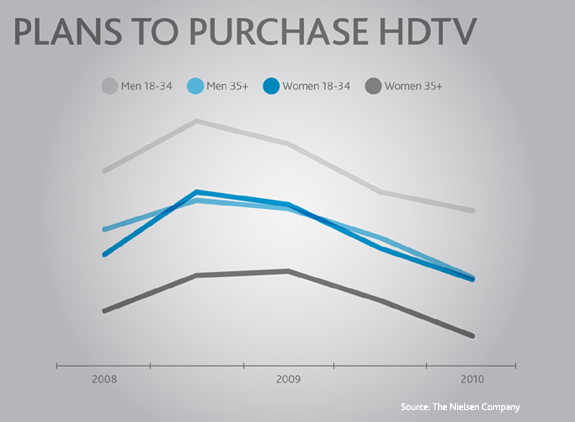Jackie Bergeron, VP, Local Audience Insights
While men have historically been considered the earliest adopters and heaviest consumers of new technology, this perception does not tell the whole story. At the recent International Women’s Media Foundation (IWMF), Sabrina Crow, SVP & Managing Director for Media Client Services at The Nielsen Company, discussed how women are just as adept at navigating the new media landscape. The key difference is that women are utilizing new technologies in their own way. In particular, women are most likely to adopt new technology when it is social and relevant—that is, when it seamlessly improves their day-to-day lives.
With many tech products, females—especially younger women—are just as likely to upgrade their consumer electronics as males. A Nielsen survey on high-definition television (HDTV) purchase intent, for example, showed U.S. women aged 18-34 are just as likely to purchase the advanced TVs as men aged 35 and over.

An Economic Force
Technology companies who may have primarily focused on reaching men are missing the fact that niche female groups are just as valuable to marketers. Increasingly, and on a global scale, today’s women are heads of households and they are more educated, more diverse, and more integral to the labor force than ever before. And, they wield an enormous amount of purchasing power .
Engage on Their Terms – Make it Social and Relevant
These trends are especially important considering the evolving media landscape. While television is still the dominant medium, consumers are spending more and more time online and engaging with mobile devices like smartphones. Consumers are actively navigating their media options, and here too, women are displaying specific behaviors. On a social level, it’s no surprise that women talk and text on their mobile devices more than men. Nielsen data shows that women talk 28 percent more and text 14 percent more than men every month; they are also heavier users of social features of phones (SMS, MMS, social networking) compared to men who tend to use functional features more (GPS, email, Internet).
Online, women are more engaged than men, spending more time on fewer sites during a single sitting—a valuable attribute to advertisers. They also visit more social and community sites, which is especially important given the popularity of immediate online/social discussion during major TV events like awards shows and reality programming.
To connect with women, make it social and relevant. Women are much more likely to engage with media that seamlessly integrates and improves their day-to-day lives. For e-commerce marketers, this means women shop online primarily for necessities like groceries, health and beauty items, and clothing. Men, on the other hand, tend to shop online for more discretionary purchases, like music, consumer electronics, and tickets to concerts or sporting events. For television advertisers, this means women tend to watch specials and awards shows live so they can engage in immediate “community viewing” discussions. And they use DVRs to time-shift recurring series programming as they fit television into their schedules when it is most convenient and relevant to them.
While time-shifting is not as high among ethnic groups, we are noting important increases. Among African-American women 18-34, DVR penetration has exploded from 11.3 percent in February 2007 to 37.4 percent today. The same trend is also true among Hispanic women. In 2007, only 10.1 percent of Hispanic women 18-34 owned a DVR, but that number has now tripled, where DVR penetration has reached 32 percent as of February 2011.
Effective Pairing
The Nintendo Wii is a perfect example of a technology product that showcases the social and relevant elements needed to effectively attract women. According to recent Nielsen data, the Wii is the most popular gaming console among women, while men tend to prefer Microsoft’s Xbox. The Wii makes gaming more social by gathering families and friends to play in groups. The Wii is also relevant to women’s lives by offering a wide array of options that allow them to spend quality time with their loved ones while making fitness fun and functional.
As women continue to break misconceptions about technology habits, so too must marketers innovate to create meaningful campaigns that embody the unique way women consume media and technology. With an expanding piece of the economic pie, women are a prime and valuable audience, but only if you can appeal to their sensibilities.


